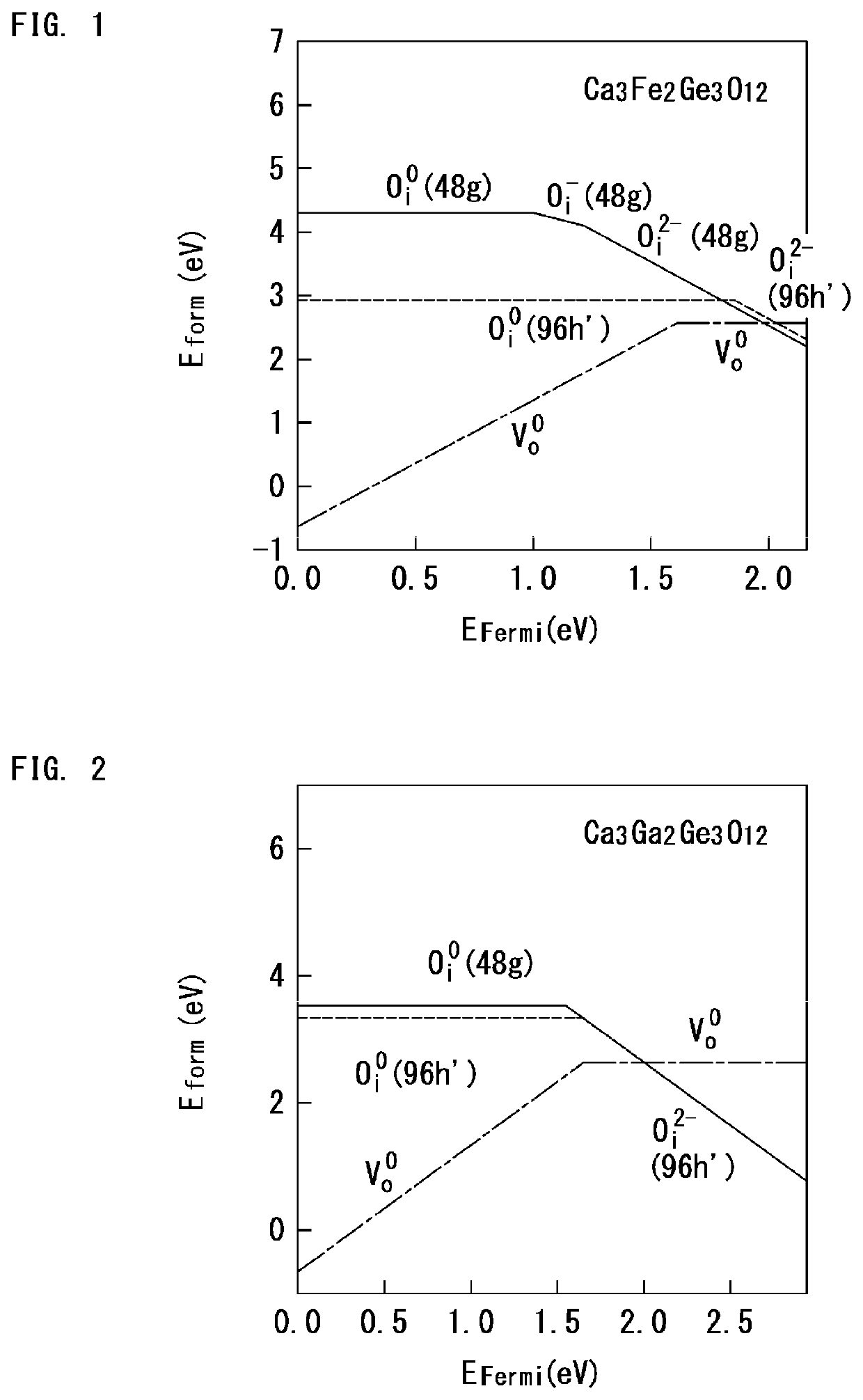Oxide ion conductor and electrochemical device
a technology applied in the field of ion conductors and electrochemical devices, can solve the problems of low redox resistance, low strength, and insufficient success of other electrolytes than ysz, and achieve the effects of reducing ion conductivity, reducing ion conductivity, and increasing the activation energy for conduction
- Summary
- Abstract
- Description
- Claims
- Application Information
AI Technical Summary
Benefits of technology
Problems solved by technology
Method used
Image
Examples
example 7
[1. Investigation of Base Composition by Quantum-Mechanical Calculation]
[0125]Synthesis capability of the oxide having the X3Z2(TO4)3 structure was investigated in terms of energy stability by quantum-mechanical calculation. Ca, Fe, Gd, Ba, or Sr was selected as the element X (positive divalent). Al, Cr, Fe, Mn, V, Ga, Co, Ni, Ru, Rh, or Ir was selected as the element Z (positive trivalent). Si, Ge, or Sn was selected as the element T (positive tetravalent).
[0126]A reaction expressed by Formula (3) was assumed as the synthesis reaction, and heat of formation for the reaction was determined according to Formula (4) by quantum-mechanical calculation.
3XO+Z2O3+3TO2→X3Z2(TO4)3 (3)
Heat of formation=E(X3Z2(TO4)3)−3E(XO)−E(TO2) (4)
[2. Results]
[0127]Based on the Ca3Fe2Ge3O12, which is found herein, another element was wholly substituted for one of the elements Ca, Fe, and Ge. Table 2 shows heat of formation for the substitution. When heat of formation is negative, the relevant oxide X3Z2 (...
example 8
[1. Sample Preparation]
[0132]Samples having various compositions were prepared as in Example 1. Nominal compositions of the samples were as follows.
[0133](a) Ca2.7La0.3Fe2Ge3O12 (Example 8.1).
[0134](b) Ca2.8La0.2Fe2Ge3O12 (Example 8.2).
[0135](c) Ca3Fe2Ge2.7Al0.3O12 (Example 8.3).
[0136](d) Ca3Fe2Ge2.8Al0.2O12 (Example 8.4).
[0137](e) Ca3Fe1.6Zn0.4Ge3O12 (Example 8.5).
[0138](f) Ca3Fe1.6Zn0.4Ge2.4Al0.6O12 (Example 8.6).
[2. Test Method]
[0139]Bulk density and ion conductivity were measured as in Example 1.
[3. Results]
[0140]Table 3 shows sintering temperature, sintering time, bulk density, and ion conductivity.
TABLE 3SinteringBulktemperatureSinteringdensityIon conductivity (S / cm)Nominal composition(° C.)time (h)(Mg / m3)500° C.600° C.700° C.Example 8.1Ca2.7La0.3Fe2Ge3O12130014.193.0E−046.4E−041.0E−03Example 8.2Ca2.8La0.2Fe2Ge3O12125013.818.6E−051.9E−043.5E−05Example 8.3Ca3Fe2Ge2.7Al0.3O12130014.391.9E−064.2E−069.7E−06Example 8.4Ca3Fe2Ge2.8Al0.2O12130014.406.1E−072.2E−066.7E−06Example 8.5Ca3F...
example 9
[1. Investigation of Base Composition by Quantum Calculation]
[0141]Investigation was made by quantum chemical calculation on ion conductivity of the oxide having the X3Z2(TO4)3 structure, where X (positive divalent) was Ca or Mg, Z (positive trivalent) was Al, Fe, or Ga, and T (positive tetravalent) was Si or Ge.
[2. Results]
[0142]The oxide ion conductivity is determined by a diffusion barrier against migration of the oxide ion. The diffusion barrier of 0.5 eV or less provides high conductivity. Calculation results revealed that, for the materials, the diffusion barrier was lower against migration of interstitial oxygen (Oi) than against migration of oxygen vacancy (Vo). Based on this, formation energy (Eform: the lower its value is, the more stable) was calculated for each of the oxygen vacancy (Vo) and the interstitial oxygen (Oi).
[0143]FIG. 1 shows a relationship between formation energy and the Fermi level of Ca3Fe2Ge3O12. FIG. 2 shows a relationship between formation energy and ...
PUM
| Property | Measurement | Unit |
|---|---|---|
| operating temperature | aaaaa | aaaaa |
| temperature | aaaaa | aaaaa |
| oxide ion conductivity | aaaaa | aaaaa |
Abstract
Description
Claims
Application Information
 Login to View More
Login to View More - R&D
- Intellectual Property
- Life Sciences
- Materials
- Tech Scout
- Unparalleled Data Quality
- Higher Quality Content
- 60% Fewer Hallucinations
Browse by: Latest US Patents, China's latest patents, Technical Efficacy Thesaurus, Application Domain, Technology Topic, Popular Technical Reports.
© 2025 PatSnap. All rights reserved.Legal|Privacy policy|Modern Slavery Act Transparency Statement|Sitemap|About US| Contact US: help@patsnap.com

